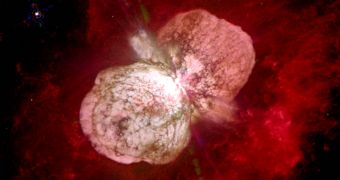Previous stellar models showed very clearly that all stars must go through a supernova stage at the end of their lives; however, a new study reveals that supermassive stars may not be able to generate supernova explosions, but they would rather suffer a sudden gravitational collapse to turn into a black hole. But if a supermassive star would be able to 'go nova', then the explosion would be relatively mild in comparison to that of their less heavy cousins.
Our star for example, the Sun, will first turn into a red giant before suffering a supernova explosion to create a white dwarf. Even stars with masses seven times smaller than that of the Sun should be able to generate a relatively powerful explosion, however the study reveals that stars 20 to 30 solar masses would simply collapse under their own weight, into a black hole, without experiencing significant power outputs.
The study was conducted by the Queen's University Belfast, based on information extracted from previous stellar explosions, including the supernova SN2006bc.
Supermassive precursors
Queen's University researchers Stephen J. Smartt and Mark Crockett, having studied the explosion of massive stars for the last decade or so, began their search of supernova precursors on images taken with the help of the Hubble Space Telescope. Each time a supernova explosion would take place, they would request NASA to send them pictures of the respective galaxy, taken before the explosion occurred in order to locate the star that created the supernova. Thus, every time they received a picture they were looking for a single star against the background of a few hundred millions of other stars.
By doing so, they could then identify the star that exploded and calculate its mass in relation to its brightness and color. Out of the stars identified to be progenitors to supernovae, the team then selected five for detailed study. It is widely believed that stars with masses up to 30 times that of the Sun, red supergiant stars, generate Type II-P supernovae and the core of the stars would be then compressed into a black hole.
Nonetheless, the study reveals that none of the Type II-P supernovae could be associated to red supergiants, more precisely stars with masses between 18 to 30 times that of the Sun are most likely to simply collapse into a black hole, without producing supernova explosions.
Theory criticism
"My main concern is whether they have enough statistics yet to confirm this," said Adam Riess, an astrophysicist at Johns Hopkins University and at the Space Science Telescope Institute in Baltimore, who oversees Hubble's science operations. "It's a little like concluding that there cannot be a much more advanced civilization than ours because they have not contacted us yet. An argument by absence. But it's very plausible." Crockett believes that in fact supermassive stars do produce powerful supernova explosions, but the fact that they haven't been observed yet seems to contradict this claim.
According to research astronomer at the University of California, Weidong Li, all supernova precursors must have maximum masses of 25 times that of the Sun, even though many astrophysicists are still not convinced that supermassive stars are able to explode. "However, very massive stars are much rarer than less massive stars, so the fact that we detect about a dozen less massive progenitors doesn't mean that stars more massive than 25 solar mass will go to black holes without a supernova explosion, or too faint to observe," Li said.
Supermassive stars are extremely rare in the universe. Supernovae have been frequently associated with supermassive precursors, although the stars themselves have never been clearly identified. SN 2006gy is just one example of such a supernova remnant. "This supernova is likely the result of a supernova explosion of a very massive star, with greater than 60 solar mass," said Li.
Supernova SN 2006bc is located in the galaxy NGC 2397, 60 million light years away from Earth, a classical spiral galaxy very similar to our own, which allowed Hubble to study individual stars inside it in great detail. The galactic nucleus is mostly populated by old red stars, while in the outer regions of the galaxy star formation is still occurring.
The supernovae findings were detailed last week at the Royal Astronomical Society National Astronomy Meeting in Belfast.

 14 DAY TRIAL //
14 DAY TRIAL //